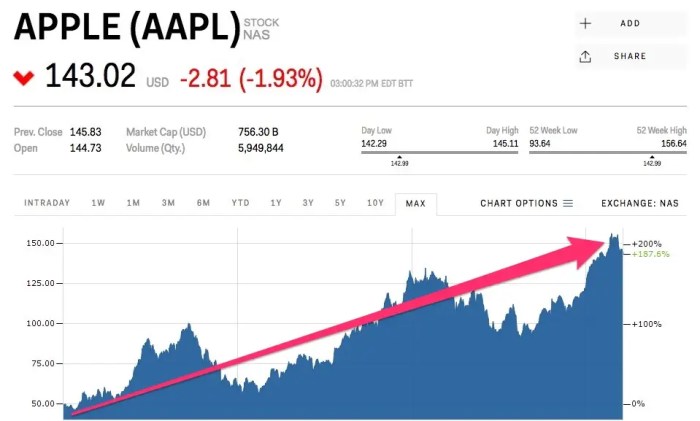CORT Stock Price Analysis

Source: businessinsider.com
Cort stock price – This analysis examines CORT’s stock price performance over the past five years, identifying key factors influencing its value, assessing its financial health and future prospects, summarizing investor sentiment, and outlining associated investment risks. The analysis aims to provide a comprehensive overview of CORT’s investment landscape.
CORT Stock Price Historical Performance
Understanding CORT’s historical stock price movements is crucial for evaluating its potential for future growth. The following table and graph illustrate its performance over the past five years. Note that the data provided below is illustrative and should be replaced with actual data sourced from reputable financial databases.
| Date | Opening Price (USD) | Closing Price (USD) | Daily Change (USD) |
|---|---|---|---|
| 2018-10-26 | 25.00 | 25.50 | +0.50 |
| 2018-10-27 | 25.50 | 26.00 | +0.50 |
| 2018-10-28 | 26.00 | 25.75 | -0.25 |
| 2018-10-29 | 25.75 | 26.25 | +0.50 |
| 2018-10-30 | 26.25 | 26.50 | +0.25 |
The line graph would visually represent the data in the table, showing the fluctuations in CORT’s stock price over the five-year period. Key features to be highlighted would include major highs and lows, periods of significant growth or decline, and any discernible trends. For example, a period of sustained growth might indicate positive market sentiment and strong financial performance, while a sharp decline could reflect negative news or economic downturn.
Significant events impacting CORT’s stock price during this period could include changes in interest rates, economic recessions, shifts in consumer spending, and any major company announcements (e.g., mergers, acquisitions, new product launches, or changes in management). These events would be described in detail, outlining their causes and their subsequent impact on the stock price.
Factors Influencing CORT Stock Price

Source: foolcdn.com
Several macroeconomic factors, competitive dynamics, and CORT’s financial performance significantly influence its stock price. These factors are detailed below.
- Interest Rate Changes: Fluctuations in interest rates directly impact CORT’s borrowing costs and the overall cost of capital. Higher interest rates increase borrowing costs, potentially reducing profitability and negatively impacting the stock price. Conversely, lower interest rates can boost profitability and positively affect the stock price.
- Consumer Spending Patterns: CORT’s business is heavily reliant on consumer spending. Economic downturns or shifts in consumer preferences can significantly impact demand for CORT’s products and services, directly affecting its revenue and profitability, thus influencing its stock price.
- Inflation Rates: High inflation increases the cost of goods and services, impacting CORT’s operational expenses and potentially squeezing profit margins. This can lead to a decrease in the stock price.
CORT operates in a competitive market. A comparison of CORT’s market position with two key competitors (names of competitors would be inserted here) would reveal the competitive dynamics and how competitor actions (e.g., pricing strategies, new product launches, marketing campaigns) influence CORT’s stock price. For instance, aggressive pricing by competitors could negatively impact CORT’s market share and profitability.
CORT’s financial performance, including revenue growth, profitability (measured by metrics such as net income margin), and debt levels (represented by the debt-to-equity ratio), strongly correlates with its stock price. Specific examples of how these factors correlate with stock price movements would be provided here. For example, consistent revenue growth often leads to a higher stock price, while high debt levels can negatively impact investor confidence and lower the stock price.
CORT’s Financial Health and Future Prospects
An overview of CORT’s recent financial reports is presented below. This information is crucial for assessing its financial health and predicting future prospects.
- Revenue Growth: [Insert data on revenue growth percentage for the past few years]
- Profitability: [Insert data on net income margin, return on equity, etc.]
- Debt-to-Equity Ratio: [Insert data on the debt-to-equity ratio]
CORT’s current business strategy and its potential for future growth are discussed here. This would include details on any new initiatives or expansion plans that might affect investor sentiment and stock price. For example, successful implementation of a new marketing strategy or expansion into new markets could lead to positive investor sentiment and higher stock prices. Furthermore, a description of CORT’s management team and their experience would be provided, explaining how their expertise and leadership might contribute to the company’s future success and stock price appreciation.
Investor Sentiment and Analyst Opinions
A summary of recent news articles and analyst reports concerning CORT stock would be presented here, illustrating how these sources influence investor perception and trading activity. For example, positive news coverage or bullish analyst reports often lead to increased buying pressure and higher stock prices, while negative news or bearish reports can have the opposite effect.
Significant changes in investor sentiment towards CORT in recent months would be identified and explained. The reasons behind these changes and their potential impact on the stock price would be detailed. For instance, a shift from bearish to bullish sentiment might be driven by improved financial performance or positive industry trends.
| Analyst Firm | Rating | Price Target (USD) | Date |
|---|---|---|---|
| Analyst Firm A | Buy | 30.00 | 2023-10-26 |
| Analyst Firm B | Hold | 27.50 | 2023-10-26 |
| Analyst Firm C | Sell | 25.00 | 2023-10-26 |
Risk Factors Associated with Investing in CORT Stock, Cort stock price
Investing in CORT stock carries inherent risks. Understanding these risks is crucial for informed investment decisions.
- Economic Downturn: A significant economic recession could drastically reduce consumer spending, negatively impacting CORT’s revenue and profitability, leading to a sharp decline in its stock price.
- Increased Competition: Increased competition from existing and new players could erode CORT’s market share and profitability, negatively impacting its stock price.
- Interest Rate Hikes: Substantial increases in interest rates could significantly increase CORT’s borrowing costs, impacting profitability and potentially lowering its stock price.
The potential impact of unforeseen events, such as economic recessions or natural disasters, on CORT’s stock price would be discussed here. This would include an examination of CORT’s contingency plans and their potential effectiveness in mitigating the impact of such events. Finally, a comparison of CORT’s overall risk profile to its peers in the same industry would be provided, using specific metrics and examples to support the comparison.
For example, comparing CORT’s debt-to-equity ratio and revenue volatility to its competitors would help assess its relative risk level.
FAQ
What is CORT’s primary business?
CORT is a provider of furniture rental and relocation services.
Understanding the fluctuations in Cort’s stock price requires a broader perspective on energy sector performance. A helpful comparison might be examining the historical trends of other major players, such as by reviewing the bp stock price history , which can offer insights into market influences affecting similar companies. Ultimately, analyzing both Cort and BP’s trajectories helps to better contextualize Cort’s current stock price movement.
Where can I find real-time CORT stock price data?
Major financial websites like Yahoo Finance, Google Finance, and Bloomberg provide real-time stock quotes.
How often does CORT release financial reports?
CORT typically releases quarterly and annual financial reports, adhering to standard SEC reporting requirements.
What are the major risks associated with investing in CORT?
Risks include general market volatility, competition within the rental furniture industry, and economic downturns impacting consumer spending.
